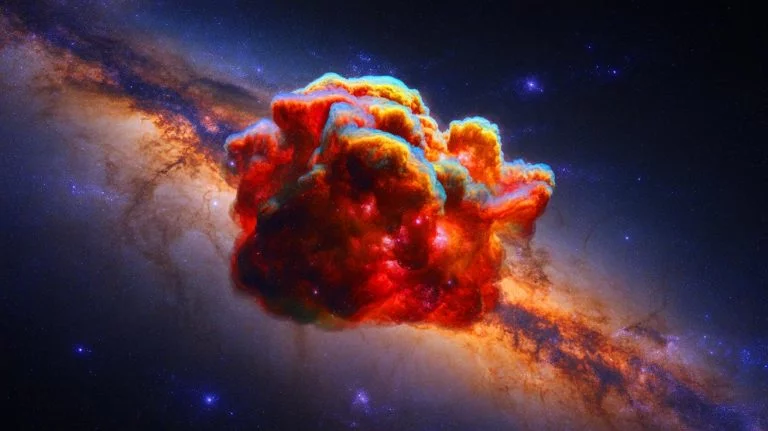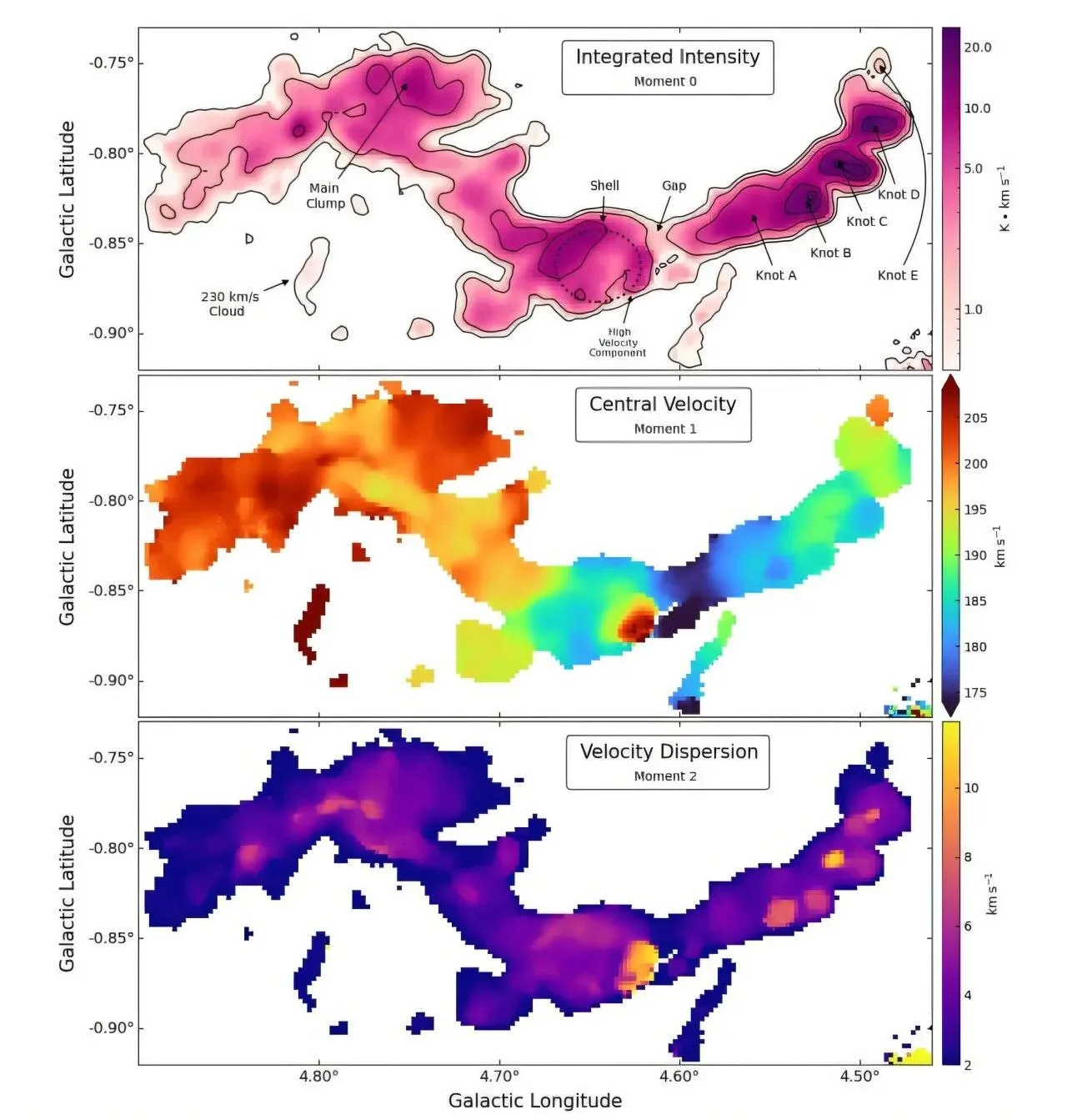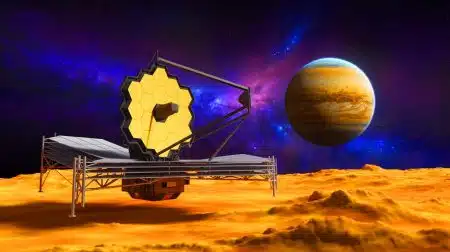| IN A NUTSHELL |
|
In an astonishing breakthrough, astronomers have identified a colossal molecular cloud within our Milky Way galaxy. This massive structure, located approximately 23,000 light-years away, weighs as much as 160,000 suns. Discovered using the Green Bank Telescope, this cloud, named M4.7-0.8, resides within a dusty lane of the galactic bar—a pivotal area for material transport to the galaxy’s core. As outlined in a study published on arXiv, this discovery provides unique insights into star formation and galactic evolution, highlighting the significance of these enormous molecular clouds.
The Significance of Giant Molecular Clouds
Giant Molecular Clouds (GMCs) are the largest formations of gas and dust in galaxies, primarily composed of molecular hydrogen. These massive clouds can exceed masses of 100,000 solar masses. Serving as the primary sites for star formation, GMCs offer the low-temperature and high-density environments conducive to the aggregation of atoms into molecules, eventually leading to star birth.
The role of GMCs in galactic evolution is paramount. By analyzing the distribution and properties of these clouds, astronomers gain a deeper understanding of star and galaxy formation and evolution. This understanding is crucial for piecing together the grand puzzle of how galaxies like our Milky Way develop over cosmic time scales.
Decoding the Mysteries of M4.7-0.8
The newly identified cloud, M4.7-0.8, spans nearly 200 light-years and has a notably cold dust temperature of approximately 20 Kelvin (-423.67°F). Within this cloud, two primary structures have been noted: the ‘Nexus’ and the ‘Filament.’ The Nexus is recognized for its bright carbon monoxide emissions, while the Filament exhibits an elongated morphology. These features suggest dynamic processes at play within the cloud, providing a fertile ground for astrochemical and dynamic studies.
Additionally, the discovery of two potential star formation zones, Knot B and Knot E, adds intrigue. Knot E, with its comet-like structure, may represent an evaporating gas globule, though further research is necessary to confirm this hypothesis. Such features underscore the complexity and dynamic nature of these stellar nurseries, offering a window into the initial stages of star formation.
Tools and Techniques in Cloud Exploration
Astronomers rely on radiotelescopes to explore molecular clouds, detecting radio waves emitted by gas molecules like carbon monoxide and ammonia. By analyzing these emissions, scientists can determine the clouds’ size, mass, and temperature, and map their structure and star-forming regions.
The use of multi-wavelength observations is vital for studying these clouds. By combining data from various instruments, researchers can construct a more comprehensive image of these vast structures. This approach enables them to piece together the physical characteristics and dynamic processes occurring within these cosmic giants, offering a richer understanding of their role in the universe.
Unveiling Galactic Evolution
The study of M4.7-0.8 underscores the critical role giant molecular clouds play in galactic evolution. With its unique characteristics, this cloud provides a rare opportunity to study these processes in detail. Future observations promise to reveal more about star formation mechanisms, potentially unveiling new insights into the lifecycle of galaxies.
Understanding these mechanisms is essential for comprehending the broader narrative of galactic evolution. As astronomers continue to explore these enigmatic clouds, the potential for groundbreaking discoveries remains vast, promising to illuminate the intricate dance of matter and energy that shapes our universe.
As we delve deeper into the mysteries of giant molecular clouds like M4.7-0.8, we stand on the brink of profound revelations about our galaxy’s past and future. What other secrets might these celestial titans hold, and how will they redefine our understanding of the cosmos?
Did you like it? 4.6/5 (20)









Wow, 160,000 suns’ worth of mass! That’s like a cosmic buffet for stars. 🍽️
Thanks for the fascinating read! How do astronomers measure the mass of such massive clouds?
This discovery is amazing. Could this cloud have any impact on earth?
I wonder if we’ll find even bigger clouds in the future. Space is full of surprises!
So, does this mean we can expect a lot of new stars forming soon?
It probably depends on what “soon” means to you. Soon as in your lifetime? No. Soon as in the next potential billion years possibly.
The universe never ceases to amaze me. Incredible discovery!
Can we get a telescope powerful enough to see this from our backyard? 🔭
Great article! But why is it called M4.7-0.8? Sounds like a math problem. 🤔
I always thought the Milky Way was just a candy bar. This is mind-blowing!
How cold is 20 Kelvin exactly? That’s hard to imagine!
I hope future observations give us more insight into star formation. Exciting times ahead!
I’m curious, how long does it take for a new star to form from these clouds?
Whoa, Knot B and Knot E sound like something out of a sci-fi movie. 🌌
This is great and all, but when can we visit? 😜
Does this discovery have any implications for dark matter research?
I love reading about these discoveries. Keep up the good work!
160,000 suns?! Imagine the solar power we could harness! ☀️
Is the ‘Nexus’ related to the Marvel universe? Just kidding, amazing find!
It’s amazing how much we still don’t know about our own galaxy.
This makes me feel so small. The universe is truly vast!
How do astronomers differentiate between different types of molecular clouds?
Cloudy with a chance of… stars? Incredible! 🌟
I’m not convinced until I see it with my own eyes! 😆
What kind of technology do they use to observe such distant objects?
Amazing discovery! How does this affect our understanding of the universe?
Could there be life in these clouds or nearby regions?
I’m fascinated by the idea of ‘star nurseries’. Such a beautiful concept!
This article is more interesting than any sci-fi novel I’ve read!
Wouldn’t it be amazing if we could travel there one day?
How many molecular clouds are there in the Milky Way?
Why is the Filament called so? Is it really like a thread?
Do these discoveries change our understanding of the Milky Way’s structure?
I hope we find something like this closer to us! 🚀
Is there any risk involved with these clouds? Like, could they explode? 😮
I’m amazed that we can detect things 23,000 light-years away. Technology is incredible!
It is crazy that we have more of space mapped out and know more about it than we do our ocean bottoms.